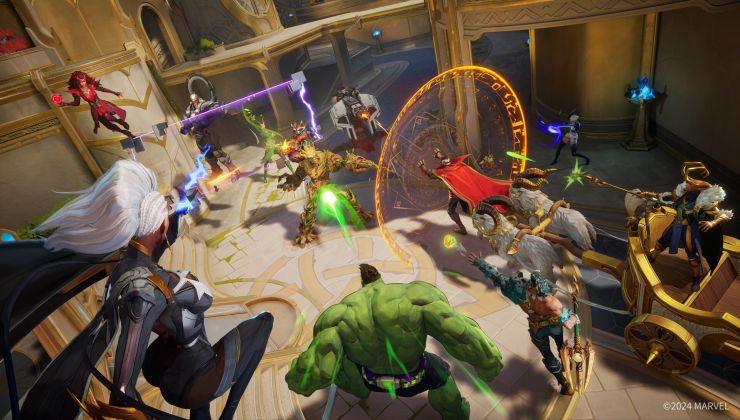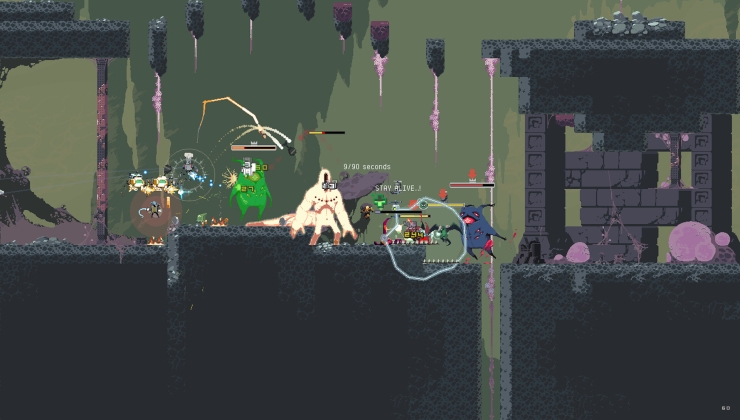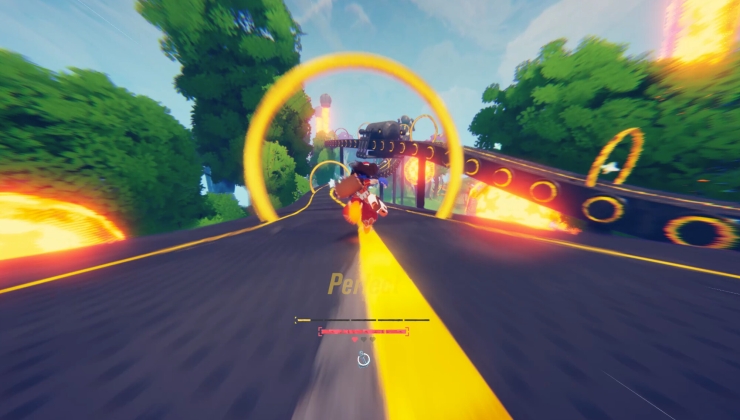One thing that is a little concerning is how much storage the bottom edition of the Valve Steam Deck will have without plugging in a microSD card, seems we now have a better idea. Thanks to a developer posting on the MetaCouncil forum, there were shots shared from behind the scenes where Valve has been posting changelogs for those with Steam Deck devkits.
Considering the low-end Steam Deck is only 64GB, it's not exactly a lot of room, although we know games will load quickly from an expansion card it's still useful to know what you've got to work with. The post shows that Valve has put SteamOS on quite the diet sitting now at 10GB.
10GB still sounds pretty big, although that does mean the low-end Steam Deck should have around 50GB. Not much of course, especially considering the colossal size of some newer games but sure is better than the original 24GB. When you think that Windows 10 needs a minimum 20GB and Windows 11 needs 64GB - it's yet another reasons for people to stick with SteamOS out of the box.
Not only that, it appears that some Steam Deck hardware has a different brand of memory between Micron and Samsung, which might just be the difference between the original devkit hardware and the newer Design Validation units.
Or are they maybe going in the silverblue-direction and include a bunch of redundant libraries?
I am sure there will be people who will figure out how to cram Windows into Steam Deck, but that's not going to be standard practice, that I am sure of.
Windows 11 needs 64GBIts minimal requirement, not real usage. [Clean w11 has 21.1 GB](https://www.minitool.com/data-recovery/how-much-space-does-windows-11-take.html).
But truth is, windows don't have preinstalled steam...
Does anyone know what the hell they are including to make it that big? Even with several proton-versions preinstalled it shouldn't get up to 10GB, let alone 24.Was wondering the same. I have a system next to me right now that is running a pretty standard, albeit minimal GNOME desktop, and it is using 5G of disk space.
Just like Windows 10, it will eat storage for breakfast for updates, that's the realistic number given by MSFT to ensure it runs properly.Windows 11 needs 64GBIts minimal requirement, not real usage. Clean w11 has 21.1 GB.
But truth is, windows don't have preinstalled steam...
Does anyone know what the hell they are including to make it that big? Even with several proton-versions preinstalled it shouldn't get up to 10GB, let alone 24.
Or are they maybe going in the silverblue-direction and include a bunch of redundant libraries?
Well, we actually already know they are going with the immutable filesystem and image based updates route like Silverblue with focus on Flatpaks for user applications. 10GB sounds reasonable if they actually provide entire desktop experience with apps ready to use. Who knows, the question is what/why was it 24GB big before and how they managed to save 14GB.
I suspect the 10GB is not just the OS but also some pre-allocated space for OS images.I think so too, they are probably using an A/B-model, which means that you have two installations of the OS at every time.
The actual OS size is probably somewhere around 3-4GB (Pop!_OS' Nvidia iso is 4.6GB) and reserving 5GB per image to account for future updates.
Or they use btrfs-subvolumes and allocate storage dynamically.
Last edited by Hooly on 16 Dec 2021 at 1:06 pm UTC
Does anyone know what the hell they are including to make it that big? Even with several proton-versions preinstalled it shouldn't get up to 10GB, let alone 24.
Or are they maybe going in the silverblue-direction and include a bunch of redundant libraries?
How much would you consider reasonable for a Linux desktop installation plus Steam and the Protons?
Does anyone know what the hell they are including to make it that big? Even with several proton-versions preinstalled it shouldn't get up to 10GB, let alone 24.Well, they'll probably need to allocate for system update, and possibly some sort of "factory reset" in case someone broke their install. There's also their custom UI that they'll probably use.
Or are they maybe going in the silverblue-direction and include a bunch of redundant libraries?
Was wondering the same. I have a system next to me right now that is running a pretty standard, albeit minimal GNOME desktop, and it is using 5G of disk space.Well, if you account for Wine, that'll add probably add 1GB. Account for factory reset and pre-allocated space for system image update as well... I think that's pretty reasonable?
Last edited by fenglengshun on 16 Dec 2021 at 1:42 pm UTC
I think so too, they are probably using an A/B-model, which means that you have two installations of the OS at every time
[...]
Or they use btrfs-subvolumes and allocate storage dynamically.
Not exactly, they run on ostree, like Fedora Silverblue. It's a bit like a git repo, or guix/nix. It has deduplication, rollback, versioning, atomic updates. That's really promising tech, I'd have picked the same.
Let's try to come up with a basic estimate
- Base Arch Install: 100 MiB
- LLVM plus mesa: 300 MiB
- Web browser: 200 MiB
- Steam: 300 MiB
- Proton: 600 MiB
- KDE Plasma plus base KDE applications: 2 GiB
- Base Flatpak runtimes (freedesktop.org, VAAPI, mesa): 700 MiB
Total: 4.2 GiB. I'm falling short, but there could be more pre-installed software like Discord, plus probably a boot partition (might be a btrfs subvolume, not sure which FS they use), and possibly a "system restore" partition that might double the size, although I would personally make that a webinstall at about 150MiB.
Any other ideas?
Last edited by MayeulC on 16 Dec 2021 at 1:46 pm UTC
Also there's the posibility that the apps they bundle use different flatpak platforms (even though these should de-duplicate) adding to the disk usage, but really having two images (so in case the main one breaks you can roll back to the previous, not sure if this is how ostree works really) sounds a sensible thing to do.
I was also wondering, if Valve will start publishing Steam officially over flathub.org at some point?
Edit: Looking at Endless OS download ISOs https://endlessos.com/download/ They are between 14GB ~ 20GB, I know they are GNOME based, but still a good reference I'd say, although they seem to bundle a lot of software/tools.
Here the output of `df -h` on a Endless OS Live Image (from distrotest.net) if anyone is curious:
live@endless:-$ df -h
df: /run/user/1000/doc: Operation not permitted
Filesystem Size Used Avail Use% Mounted on
devtmpfs 1.5G 0 1.5G 0% /dev
tmpfs 1.5G 84K 1.5G 1% /dev/shm
tmpfs 597M 40M 558M 7% /run
tmpfs 5.0M 0 5.0M 0% /run/lock
/dev/mapper/endless-image3 31G 31G 454M 99% /sysroot
eos-live-boot 597M 40M 558M 7% /boot
eos-live-etc 597M 40M 558M 7% /etc
eos-live-var 597M 40M 558M 7% /var
tmpfs 1.5G 0 1.5G 0% /tmp
ens-live-sry 597M 40M 558M 7% /sry
eos-live-sysroot/home 597M 40M 558M 7% /sysroot/home
eos-live-sysroot/ostree 597M 40M 558M 7% /sysroot/ostree
tmpfs 299M 188K 299M 1% /run/user/1000
/dev/sr0 18G 18G 0 100% /run/media/live/Endless-OS-4-0-0-enLast edited by minkiu on 16 Dec 2021 at 2:16 pm UTC
Who knows, the question is what/why was it 24GB big before and how they managed to save 14GB.
Maybe they used to have a whole distro with every irrelevant lib and app installed, then went and trimmed that. Like I think LibreOffice is installed by default on many distros, but obviously the deck doesn't need that.
Maybe they used to have a whole distro with every irrelevant lib and app installed, then went and trimmed that. Like I think LibreOffice is installed by default on many distros, but obviously the deck doesn't need that.It's Arch, it doesn't have anything "irrelevant" preinstalled.
Or they use btrfs-subvolumes and allocate storage dynamically.
Unlikely, since BTRFS does not have casefolding which Proton uses. Casefolding for now is only available with ext4.
Maybe they used to have a whole distro with every irrelevant lib and app installed, then went and trimmed that. Like I think LibreOffice is installed by default on many distros, but obviously the deck doesn't need that.It's Arch, it doesn't have anything "irrelevant" preinstalled.
It's not Arch. It's SteamOS, which is arch-based. It can, and likely will, have plenty of "irrelevant" libraries, since Valve will no doubt be thinking of use-cases we have no sight of just yet. It could be literally crammed full of what we'd consider to be irrelevant baggage.
I think so too, they are probably using an A/B-model, which means that you have two installations of the OS at every time
[...]
Or they use btrfs-subvolumes and allocate storage dynamically.
Not exactly, they run on ostree, like Fedora Silverblue. It's a bit like a git repo, or guix/nix. It has deduplication, rollback, versioning, atomic updates. That's really promising tech, I'd have picked the same.
Let's try to come up with a basic estimate
- Base Arch Install: 100 MiB
- LLVM plus mesa: 300 MiB
- Web browser: 200 MiB
- Steam: 300 MiB
- Proton: 600 MiB
- KDE Plasma plus base KDE applications: 2 GiB
- Base Flatpak runtimes (freedesktop.org, VAAPI, mesa): 700 MiB
Total: 4.2 GiB. I'm falling short, but there could be more pre-installed software like Discord, plus probably a boot partition (might be a btrfs subvolume, not sure which FS they use), and possibly a "system restore" partition that might double the size, although I would personally make that a webinstall at about 150MiB.
Any other ideas?
Where did you get a base install size of 100MiB? Granted, I am on Ubuntu but
- the minimal kernel alone (no modules) requires 110MB of disc space. Add some kernel modules, firmware, basic libraries and GNU tools...
- Browser? Which one? Firefox comes in at around 250MiB, Chromium is considerably larger.
- Steam? Runtime and libs - we are getting into GiBs without any Proton version (bin32 - 800+MiB, bin64 - 300MiB,...)
- Mesa? The 64bit libgl1-mesa-dri reports 456MB, the i386 version 439MB plus Vulkan drivers. llvm clocks in at 100MiB per architecture.
That's Ubuntu, but I seriously doubt that Arch can do with a mere fraction of these binary sizes.
Or they use btrfs-subvolumes and allocate storage dynamically.
Unlikely, since BTRFS does not have casefolding which Proton uses. Casefolding for now is only available with ext4.
Hmmm I actually use proton on top of btrfs, what issues will this cause ? Can I assume some of my games are broken because of that ?
it make a lot of sense:
valve save bandwitdh by not having to distribute proton alongside the games for everyone who purchase an steam deck, instead it already come pre installed.
and it make it easier to manage.
just think about it:
lets say we have 2 games that use 100MB of storage and need the same version of proton to run, lets say: proton 6.3 (34MB)
the user will be confused if he see this situation:
you need 134 MB to install game A, and 134MB to install game B.
but if you have A installed you only need 100MB to install B, and if you have B installed you only need 100MB to install A.
if you only unistall one game, you free'd 100MB of disk space, but if you unistall both you free 234MB.
those games arent even from the same company to share any code/assets, so that problem dont make any sense for the end user, it just make it more confusing to manage your remaining storage.
10GB is A LOT of space for an linux distro, so i hope it also include some space for cache , for games/applications who need virtual ram, since 8GB might not be enough for then, and/or an copy of the OS as it came from factory for those who want/need to reset to factory settings.
Last edited by elmapul on 16 Dec 2021 at 4:56 pm UTC















 How to set, change and reset your SteamOS / Steam Deck desktop sudo password
How to set, change and reset your SteamOS / Steam Deck desktop sudo password How to set up Decky Loader on Steam Deck / SteamOS for easy plugins
How to set up Decky Loader on Steam Deck / SteamOS for easy plugins
See more from me